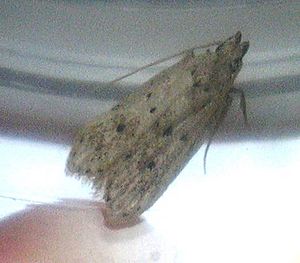Autosticha facts for kids
Quick facts for kids Autosticha |
|
|---|---|
 |
|
| Autosticha gelechid moth (Autosticha pelodes) | |
| Scientific classification | |
| Kingdom: | |
| Phylum: | |
| Class: | |
| Order: | |
| Family: |
Autostichidae
|
| Subfamily: |
Autostichinae
|
| Genus: |
Autosticha
Meyrick, 1886
|
| Type species | |
| Automola pelodes Meyrick, 1883
|
|
| Synonyms | |
|
|
Autosticha is a group of small moths. These moths belong to a larger family called Autostichidae. They are part of the huge group of insects known as Lepidoptera, which includes all moths and butterflies.
Scientists call Autosticha moths "basal micromoths." This means they are very tiny and represent an older branch on the moth family tree. Not a lot is known about these specific moths. However, we can learn about them by understanding moths in general.
Contents
What Are Autosticha Moths?
Autosticha is a genus of moths. A genus is a scientific grouping of very similar living things. All the moths in the Autosticha genus share many common features. They are part of the Gelechoidea superfamily. A superfamily is an even larger group that includes several related moth families.
Tiny Moths, Big Family
The term "micromoth" means "tiny moth." Many moths are quite small, and micromoths are among the smallest. They often have wingspans of less than 20 millimeters (about 0.8 inches). Despite their small size, they play important roles in nature.
The Autosticha genus was first described by a scientist named Edward Meyrick in 1886. He was a famous British entomologist who studied insects, especially moths. Naming new species and groups helps scientists organize and understand the natural world.
Where Do They Live?
Because not much is known about Autosticha moths, their exact habitats are not fully documented. However, moths in general live all over the world. They can be found in forests, grasslands, deserts, and even in cities. They often prefer places with plenty of plants, as most moth larvae (caterpillars) eat plants.
Life Cycle of a Moth
Like all moths, Autosticha moths go through a process called metamorphosis. This means they change completely during their lives. There are four main stages:
- Egg: A female moth lays tiny eggs, often on a plant.
- Larva (Caterpillar): The egg hatches into a larva, which we call a caterpillar. Caterpillars spend their time eating and growing. They shed their skin several times as they get bigger.
- Pupa: Once the caterpillar is fully grown, it forms a pupa. For many moths, this stage is inside a cocoon. Inside the pupa, the caterpillar's body changes into an adult moth.
- Adult: The adult moth emerges from the pupa. Its main job is to find a mate and lay eggs, starting the cycle again. Adult moths often drink nectar from flowers.
Discovering New Species
Scientists are always discovering new species of moths and other creatures. When a new species is found, it needs a scientific name. Sometimes, a species might be given a name that was already used for another animal. This is called being "preoccupied."
For example, the genus Automola was once used for some Autosticha moths. But that name was already used for a type of fly. So, scientists had to give the moths a new, unique name. This is why you might see "synonyms" listed in scientific information. Synonyms are older names that are no longer used.
Studying moths like Autosticha helps us understand biodiversity. It also shows us how much more there is to learn about the tiny creatures sharing our planet.

